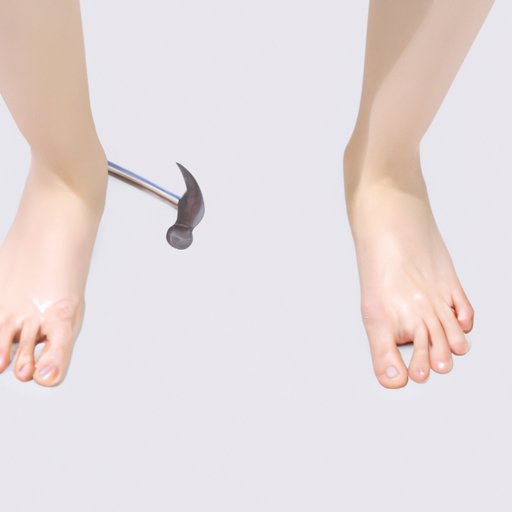I. Introduction
Hammer toe is a common condition that can cause significant discomfort and impact daily life. This article will provide an overview of the causes and symptoms of hammer toe, as well as the different treatments available. Additionally, we will explore tips for reducing the risk of developing the condition, and highlight the impact of hammer toe on daily activities.
II. Causes and Symptoms of Hammer Toe
Hammer toe is a foot deformity that occurs when the toe’s middle joint becomes bent out of shape. This condition can develop as a result of genetics, underlying health conditions, or certain lifestyle factors. There are two different types of hammer toe: flexible and rigid. Flexible hammer toe can be straightened with gentle manipulation, while rigid hammer toe cannot be moved without surgery.
The most common causes of hammer toe include wearing shoes that are too tight or too short, foot injuries, and arthritis. Symptoms of hammer toe include pain and discomfort in the affected toe, a visible deformity, difficulty walking or standing for prolonged periods, and corns or calluses on the top of the toe or sole of the foot.
III. Different Treatments for Hammer Toe
There are a variety of treatments available for hammer toe, ranging from conservative options to surgery. Conservative treatments for hammer toe include physical therapy, toe stretching exercises, and wearing shoes with a wide and deep toe box. Other treatments may include padding and taping the affected toe, using custom orthotics or inserts, and taking pain relievers.
In more severe cases of hammer toe, surgery may be necessary to correct the deformity. Surgical options for hammer toe typically involve removing or repositioning the bone, tendon, or ligament that is causing the condition.
Prevention is an important part of managing hammer toe. To prevent the condition from developing or worsening, it is essential to wear comfortable shoes with ample space to wiggle toes, avoid high heels or pointy shoes, stretch your toes and feet regularly, and maintain a healthy weight.
IV. Background Information and Risk Factors
Although anyone can develop hammer toe, certain factors can increase your risk. Those who have past foot injuries, arthritis, or nerve damage may be more likely to develop this condition, along with individuals who wear shoes that do not fit properly. Genetics can also play a role in the development of hammer toe.
To reduce your risk of developing this condition, it is important to wear shoes that are supportive, have plenty of toe room, and fit properly. If you are experiencing any discomfort or pain in your feet or toes, talk to your doctor about ways to manage your symptoms and reduce your risk of developing hammer toe.
V. Impact of Hammer Toe on Day-to-Day life
Hammer toe can have a significant impact on daily activities, particularly when it comes to exercise and fitness. If you have hammer toe, it is important to choose activities that are low-impact and avoid those that put pressure on the affected toe. Swimming, biking, and yoga can be good exercise choices for those with hammer toe, but it is important to talk to your doctor before starting any new exercise program.
If you experience any pain or discomfort while exercising, stop the activity immediately and consult your doctor. With proper treatment and management, you can continue to participate in the physical activities you enjoy while managing your hammer toe.
VI. Stories of Recovery
Speaking to people who have successfully treated their hammer toe can be a valuable source of insight and inspiration. One individual we spoke with had a flexible hammer toe and was able to correct the condition using toe stretching exercises and wearing shoes with ample toe room. Another individual we spoke with had a more severe case of hammer toe and required surgery to correct the deformity.
Both individuals emphasized the importance of seeking medical treatment and following a treatment plan that works for your specific type of hammer toe. They also stressed the importance of being patient throughout the treatment process and not expecting results overnight.
VII. Conclusion
Hammer toe is a common condition that can cause significant discomfort and impact daily life. However, with proper treatment and management, it is possible to minimize the impact of this condition on your daily activities. Whether you are seeking conservative treatments or require surgery to correct the condition, it is important to work with your doctor to develop a personalized treatment plan that works for you.
Remember to take steps to prevent hammer toe from developing or worsening, including wearing comfortable shoes, stretching your toes regularly, and maintaining a healthy weight. If you are experiencing any discomfort or pain in your feet or toes, talk to your doctor about ways to manage your symptoms and reduce your risk of developing hammer toe.
